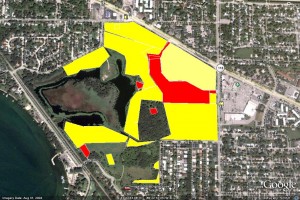Commentary
Madison Board of Parks Commissioners on Sept. 8, 2009:
My name is Jim Carrier. I am Writer and filmmaker, with Books on Yellowstone NP, and articles in the National Geographic. I’m also a homeowner adjacent to Warner Park.
We share our back yard with half a million people a year, mostly in the summer.  They use the majority of the park (the colored parts on the photo: Red is parking lot, and yellow is mowed lawn, a dog park, or ballfields)
They use the majority of the park (the colored parts on the photo: Red is parking lot, and yellow is mowed lawn, a dog park, or ballfields)
But the park is also used by thousands of birds, fish and animals who raise families in the trees, waters, wetlands and grasslands of Warner Park. They are pushed into what is not mowed or paved.
The care with which the people of the Northside were surveyed for this plan is admirable. Unfortunately, no one spoke for wildlife. Thus, we have a plan that wounds this fragile park with a dozen cuts – a parking lot here, a sidewalk there, and dredging to make room for boats.
When I began to question the staff, we found that two items – a soccer field in a meadow, and pontoon boats in the lagoon, were mistakes. Worse, none of these so-called “conceptual” ideas — which would cut trees, increase runoff, dredge a nursery for fish and migratory birds, and spread more human use into wildlife habitat– had been put to review by the park ecologist or DNR – until we asked, and my petition for a review by the Environment Committee has been denied.
Words have power. Written down in a plan, they take on life of their own. I worked with staff to craft alternate concepts. But I came to feel that this was putting band-aids on what amounts to a pro development park plan.
If you want to change Warner Park, a piece-meal attachment to a neighborhood plan seems the wrong way to go about it. If you are not happy with the park as it is, I would ask you to set in motion another master plan process that includes an environmental impact study. As you well know one of the standard options in an EIS is “Do Nothing.” Until we begin to see Warner Park as a precious, multiple-use ecosystem, that’s just what we should do.
You must be logged in to post a comment.